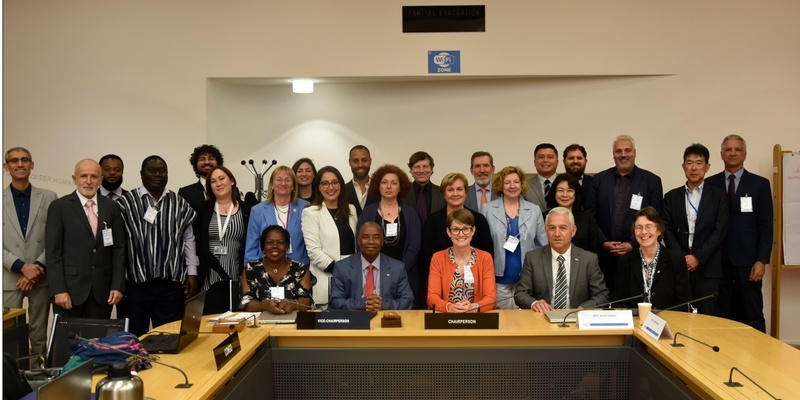Standards Committee and Standards Committee Working Group approve five standards for consultation
Posted on Mon, 20 May 2024, 07:22

© IPPC Secretariat
Rome, 16 May 2024. The Standards Committee (SC) and the Standards Committee Working Group (SC-7) of the International Plant Protection Convention (IPPC) approved five draft International Standards for Phytosanitary Measures (ISPMs), one draft specification for consultation and four phytosanitary treatments for consultation by contracting parties and regional plant protection organizations (RPPOs).
The SC and the SC-7 have distinct roles in the standard setting procedure. Annually in May, the SC reviews and approves draft ISPMs for first consultation, then SC-7 approves them for second consultation. Subsequently, they are considered by the SC in November for potential recommendation for adoption by the Commission on Phytosanitary Measures (CPM).
SC approves draft ISPMs for first consultation
Draft revision of ISPM 26 Establishment and maintenance of pest free areas for fruit flies (Tephritidae). Adopted in 2006, ISPM 26 provides guidance to national plant protection organizations (NPPOs) on the establishment and maintenance of pest free areas (PFAs) for fruit flies of economic importance. An example is the genus Ceratitis, which includes species that damage crops used for commercial and subsistence agriculture. A diagnostic protocol was recently adopted on genus Ceratitis.
The SC is revising the requirements to ensure an effective and cohesive approach to the establishment of PFAs for tephritid fruit flies and to improve consistency with the new version of ISPM 4 Requirements for the establishment of pest free areas and ISPM 8 Determination of pest status in an area.
Draft annex to ISPM 23 Guidelines for inspection: Field inspection. Field inspection of plants in fields is an important phytosanitary measure, applied to detect regulated pests or signs or symptoms of regulated pests. It also, and to verify conformity with phytosanitary requirements to reduce the pest risk associated with the international movement of plants.
Although several ISPMs refer to field inspection in a general way, they do not provide any specific guidance on field inspection, resulting in unharmonized implementation of field inspections by countries. An annex to ISPM 23 Guidelines for inspection was thus developed to describe a common understanding of the concept, objectives and process of field inspection as well its requirements to provide guidance to NPPOs for its appropriate interpretation and application.
Draft annex to ISPM 38 International movement of seeds: Design and use of systems approaches for phytosanitary certification of seeds. To reduce pest risk throughout the seed production process from planting to harvesting, the draft annex provides a general and standardized framework of requirements to NPPOs for developing systems approaches for seeds as an option for phytosanitary certification. This helps to meet the phytosanitary requirements of importing countries.
Several entities involved in the seed supply chain, such as seed producers and companies performing treatments. Can be involved in the systems approach, alongside NPPOs. Collaboration is essential and so the draft annex outlines the responsibilities of both NPPOs and participating entities.
SC approves draft specification for consultation
Draft specification on revision of the draft reorganized pest risk analysis (PRA) ISPMs. Pest risk analysis is a core process within the IPPC’s scope and an important science-based evaluation tool for NPPOs. PRA is used to identify and determine if an organism is a pest and pathway of concern or whether pests qualify as regulated pests. It is also used to identify the options for phytosanitary measures that are appropriate to manage the risk of introduction and spread of pests in a specified PRA area. ISPM revisions were intended to reorganize the PRA-related ISPMs to streamline the text, emphasize the requirements and obligations for PRA in the IPPC context, and to provide greater clarity for all contracting parties to understand and use.
The specification is a core step in the standard setting procedure. Following the consultation period, SC reviews and potentially approves the specification. An expert working group is then formed to elaborate the draft reorganized pest risk analysis (PRA) ISPMs.
Through an e-decision, the SC also approved for first consultation, four phytosanitary treatments as draft annexes to ISPM 28 Phytosanitary treatments for regulated pests:
- Combination of irradiation and modified atmosphere treatment for Trogoderma granarium ;
- Irradiation Treatment for Pseudococcus Baliteus;
- Irradiation Treatment for Paracoccus Marginatus; and
- Irradiation Treatment for Planococcus Lilacinus.
“The Standards Committee worked hard to find common ground on key topics such as pest free areas, field inspection, systems approach for phytosanitary certification of seeds and pest risk analysis,” said Sophie Peterson, the SC Chair.
“With the first round of consultations starting on 1 July, contracting parties and RPPOs will have the opportunity to provide their comments and inputs to improve the texts,” she added.
SC-7 approves draft ISPMs for second consultation
Draft annex to ISPM 46 Commodity-specific standards for phytosanitary measures: International Movement of fresh Mangifera indica Fruit. The first commodity standard to be developed is for the mango fruit, a widely traded global commodity. The draft annex provides guidance for NPPOs on pests associated with fresh mango fruit and general and pest-specific options for phytosanitary measures in the international movement of mango fruit.
Draft annex to ISPM 39 International movement of wood: Use of systems approaches in managing the pest risks associated with the movement of wood. As countries predominantly rely on treatments and processing to manage the pest risks associated with the movement of wood across their borders, the draft annex provides NPPOs with specific technical guidance on the development of a wood-commodities systems approach. It also provides several examples of practices and measures that may reduce pest risk associated with wood from pre-planting to transport.
“The trade of mango fruit and the movement of wood are very important topics in international trade and these draft standards were highly expected. The SC-7 did a great job in the review and addressing country comments,” stated André Felipe C. P. da Silva, Chair for this SC-7 meeting.
Related information

